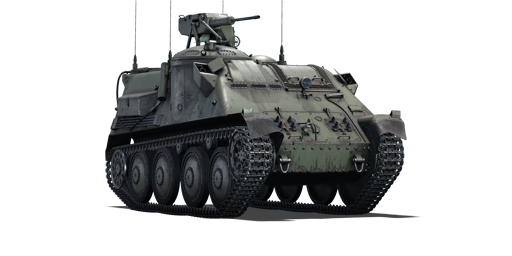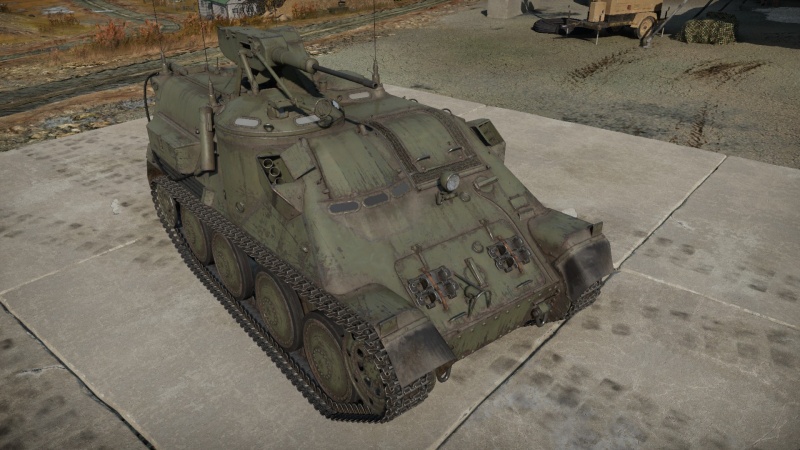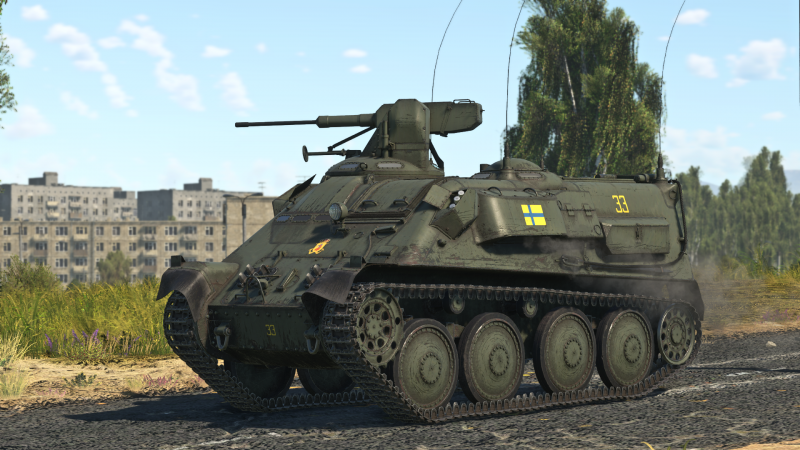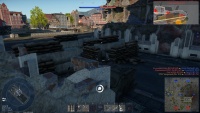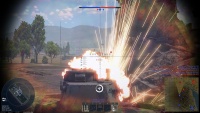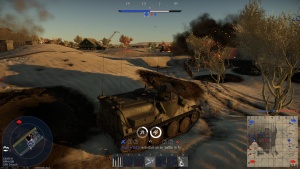Difference between revisions of "Pbv 301"
m (→See also) |
Colok76286 (talk | contribs) (Edits) |
||
| (16 intermediate revisions by 9 users not shown) | |||
| Line 1: | Line 1: | ||
{{Specs-Card | {{Specs-Card | ||
|code=sw_pbv_301 | |code=sw_pbv_301 | ||
| − | |images={{Specs-Card-Image|GarageImage_{{PAGENAME}}.jpg}} | + | |images={{Specs-Card-Image|GarageImage_{{PAGENAME}}.jpg|ArtImage_{{PAGENAME}}.png}} |
}} | }} | ||
== Description == | == Description == | ||
<!-- ''In the description, the first part should be about the history of the creation and combat usage of the vehicle, as well as its key features. In the second part, tell the reader about the ground vehicle in the game. Insert a screenshot of the vehicle, so that if the novice player does not remember the vehicle by name, he will immediately understand what kind of vehicle the article is talking about.'' The text within these arrows are not to be deleted --> | <!-- ''In the description, the first part should be about the history of the creation and combat usage of the vehicle, as well as its key features. In the second part, tell the reader about the ground vehicle in the game. Insert a screenshot of the vehicle, so that if the novice player does not remember the vehicle by name, he will immediately understand what kind of vehicle the article is talking about.'' The text within these arrows are not to be deleted --> | ||
| − | The '''{{Specs|name}}''' is a | + | The '''{{Specs|name}}''' is an Swedish infantry fighting vehicle based on the aging [[Strv m/41 S-II|Strv m/41]] hulls that were no longer intended for service, the rebuilding of these hulls were tasked to Hägglund & Söner on design to have a vehicle able to safely carry a squad of 8 fully equipped soldiers that were gonna be used by the Swedish Army. A total of 220 [[Strv m/41 S-II|Strv m/41]]'s were converted to {{PAGENAME}}, where it would have a short service life but would prove valuable lessons for the upcoming Pbv 302 that were gonna replace them. {{PAGENAME}} were just an temporary solution in an situation where they needed vehicles for the infantry to keep up with the tanks. Upon being able to carry eight soldiers, the {{PAGENAME}} were also equipped an oscillating casing with an 20 mm [[Akan m/45B (20 mm)|Akan m/45B]] taken from old decommissioned [[J21A-2]]'s to be able provide an direct fire support for the infantry, being able to deal with both hostile infantry and lightly-armoured vehicles. The infantry could also fight from inside the vehicle via two hatches on the roof of the vehicle providing cover for the {{PAGENAME}} if the main armament were occupied with other targets. It service were from 1962 and were gonna be the troop transport for the armoured brigades until it were gonna be phased out in the early 1970s in favour of the newer Pbv 302. |
| + | |||
| + | Introduced in [[Update "Direct Hit"]], the Pbv 301 is a fully enclosed infantry fighting vehicle within the Swedish Army's beginner ranks. The Pbv 301 has a low profile, thus allowing players to simply hide behind obstacles to avoid unwanted attention from adversaries. The weapon has a high rate of fire and can attack both ground targets and low-flying aircraft. Furthermore, it is outfitted with hull-mounted smoke grenades to enable retreat in difficult situations, which is a feature that is unique among its counterparts. However, due to its incredibly low crew count (just two crew members), the chances of surviving penetrating shots are quite poor. Finally, since the vehicle has a high reload time, it is critical for players to save ammunition throughout combat. | ||
== General info == | == General info == | ||
| Line 12: | Line 14: | ||
{{Specs-Tank-Armour}} | {{Specs-Tank-Armour}} | ||
<!-- ''Describe armour protection. Note the most well protected and key weak areas. Appreciate the layout of modules as well as the number and location of crew members. Is the level of armour protection sufficient, is the placement of modules helpful for survival in combat? If necessary use a visual template to indicate the most secure and weak zones of the armour.'' The text within these arrows are not to be deleted --> | <!-- ''Describe armour protection. Note the most well protected and key weak areas. Appreciate the layout of modules as well as the number and location of crew members. Is the level of armour protection sufficient, is the placement of modules helpful for survival in combat? If necessary use a visual template to indicate the most secure and weak zones of the armour.'' The text within these arrows are not to be deleted --> | ||
| − | The {{PAGENAME}} is a small casemate with a sloped front. The driver and the gunner are located on its right front side, while the engine is located on the left. The back has spare magazines on the floor and otherwise is completely empty. | + | The {{PAGENAME}} is a small casemate with a sloped front. The driver and the gunner are located on its right front side, while the engine is located on the left. The back has spare magazines on the floor and otherwise is completely empty. |
Due to a slope and the 20 mm of RHA, the hull front will sustain 12.7 mm machine guns and might sustain 20 mm fire from the low ground (but not the high ground) or from about 500 m away. The lower frontal plate is 50 mm RHA and will sustain some explosions. | Due to a slope and the 20 mm of RHA, the hull front will sustain 12.7 mm machine guns and might sustain 20 mm fire from the low ground (but not the high ground) or from about 500 m away. The lower frontal plate is 50 mm RHA and will sustain some explosions. | ||
| Line 32: | Line 34: | ||
! Armour !! Front (Slope angle) !! Sides !! Rear !! Roof | ! Armour !! Front (Slope angle) !! Sides !! Rear !! Roof | ||
|- | |- | ||
| − | | Hull || 50 mm (14°) ''Front plate'' <br> 8 mm (63°) ''Lower glacis'' || | + | | Hull || 50 mm (14°) ''Front plate'' <br> 8 mm (63°) ''Lower glacis'' || 15 mm ''Bottom'' || 8 mm |
! | ! | ||
|- | |- | ||
| Casemate || 20 mm (53°) ''Upper glacis'' <br> 10 mm ''Gun mantlet'' || 8 mm (20°) ''Top'' || 8 mm || 20 mm (37°) ''Front glacis'' <br> 10 mm ''Crew compartment'' | | Casemate || 20 mm (53°) ''Upper glacis'' <br> 10 mm ''Gun mantlet'' || 8 mm (20°) ''Top'' || 8 mm || 20 mm (37°) ''Front glacis'' <br> 10 mm ''Crew compartment'' | ||
|- | |- | ||
| − | | Gun mount || | + | | Gun mount || colspan="3" | 15 mm (spherical) || 10 mm ''Centre'' <br> 15 mm ''Outer ring'' |
|- | |- | ||
|} | |} | ||
| Line 63: | Line 65: | ||
The gun is similar to 40B on the previous SPAA, but with a lot of quality of life upgrades. | The gun is similar to 40B on the previous SPAA, but with a lot of quality of life upgrades. | ||
| − | There are now 6 belts with 75 shells each, and the gun can fire twice as fast, allowing for smoother shell streams. The turret turns a bit faster and allows the gun to turn slightly more down or up. All of this ensures that SPAA can take down planes before they get into the dead zone. | + | There are now 6 belts with 75 shells each, and the gun can fire twice as fast, allowing for smoother shell streams. The turret turns a bit faster and allows the gun to turn slightly more down or up. All of this ensures that SPAA can take down planes before they get into the dead zone. |
The {{PAGENAME}} still can fight back against other tanks, whether by firing at their weak spots, or by breaking their tracks (to force them to turn) and then hitting their side or running away. It is ill-advised to attack medium tanks frontally, particularly of higher BR. Most heavy tanks will ignore the 20 mm fire with the present ammunition. Most British and Soviet tanks at a higher BR are immune to the 20 mm attacks (in the case of the British, even their SPAAs can in some situations be immune to 20 mm cannon fire). | The {{PAGENAME}} still can fight back against other tanks, whether by firing at their weak spots, or by breaking their tracks (to force them to turn) and then hitting their side or running away. It is ill-advised to attack medium tanks frontally, particularly of higher BR. Most heavy tanks will ignore the 20 mm fire with the present ammunition. Most British and Soviet tanks at a higher BR are immune to the 20 mm attacks (in the case of the British, even their SPAAs can in some situations be immune to 20 mm cannon fire). | ||
| Line 80: | Line 82: | ||
|- | |- | ||
! ''Arcade'' | ! ''Arcade'' | ||
| − | | rowspan="2" | 450 (75) || rowspan="2" | 725 || rowspan="2" | -15°/+48° || rowspan="2" | ±180° || rowspan="2" | N/A || 26.4 || 36. | + | | rowspan="2" | 450 (75) || rowspan="2" | 725 || rowspan="2" | -15°/+48° || rowspan="2" | ±180° || rowspan="2" | N/A || 26.4 || 36.6 || 44.4 || 49.1 || 52.2 || rowspan="2" | 10.40 || rowspan="2" | 9.20 || rowspan="2" | 8.48 || rowspan="2" | 8.00 |
|- | |- | ||
! ''Realistic'' | ! ''Realistic'' | ||
| Line 88: | Line 90: | ||
==== Ammunition ==== | ==== Ammunition ==== | ||
| + | |||
* '''Default:''' {{Annotation|AP-T|Armour-piercing tracer}}{{-}}{{Annotation|HEFI-T|High-explosive fragmentation incendiary tracer}}{{-}}{{Annotation|HEFI-T|High-explosive fragmentation incendiary tracer}} | * '''Default:''' {{Annotation|AP-T|Armour-piercing tracer}}{{-}}{{Annotation|HEFI-T|High-explosive fragmentation incendiary tracer}}{{-}}{{Annotation|HEFI-T|High-explosive fragmentation incendiary tracer}} | ||
* '''slsgr m/42:''' {{Annotation|HEFI-T|High-explosive fragmentation incendiary tracer}} | * '''slsgr m/42:''' {{Annotation|HEFI-T|High-explosive fragmentation incendiary tracer}} | ||
* '''slpgr m/42:''' {{Annotation|AP-T|Armour-piercing tracer}} | * '''slpgr m/42:''' {{Annotation|AP-T|Armour-piercing tracer}} | ||
| − | { | + | {{:Akan m/45B (20 mm)/Ammunition|Default AP-T, slsgr m/42, slpgr m/42}} |
| − | |||
| − | |||
| − | |||
| − | |||
| − | |||
| − | |||
| − | |||
| − | |||
| − | |||
| − | |||
| − | |||
| − | |||
| − | |||
| − | |||
| − | { | ||
| − | |||
| − | |||
| − | |||
| − | |||
| − | |||
| − | |||
| − | |||
| − | |||
| − | |||
| − | |||
| − | |- | ||
| − | |||
| − | |||
| − | |||
| − | |||
| − | |||
| − | |||
| − | |||
==== [[Ammo racks]] ==== | ==== [[Ammo racks]] ==== | ||
| Line 170: | Line 140: | ||
* Side, back and roof armour is still lacking and vulnerable to rifle-calibre machine gun fire at close range and to airstrikes in general | * Side, back and roof armour is still lacking and vulnerable to rifle-calibre machine gun fire at close range and to airstrikes in general | ||
| − | * Only 2 crew members, very low chance of surviving a penetrating shot, unless it was from the left | + | * Only 2 crew members, very low chance of surviving a penetrating shot, unless it was from the left |
* Limited gun elevation angle, it's necessary to pay attention to the skies before it is too late | * Limited gun elevation angle, it's necessary to pay attention to the skies before it is too late | ||
* Long reload time and rather limited belt capacity | * Long reload time and rather limited belt capacity | ||
| Line 177: | Line 147: | ||
== History == | == History == | ||
<!-- ''Describe the history of the creation and combat usage of the vehicle in more detail than in the introduction. If the historical reference turns out to be too long, take it to a separate article, taking a link to the article about the vehicle and adding a block "/History" (example: <nowiki>https://wiki.warthunder.com/(Vehicle-name)/History</nowiki>) and add a link to it here using the <code>main</code> template. Be sure to reference text and sources by using <code><nowiki><ref></ref></nowiki></code>, as well as adding them at the end of the article with <code><nowiki><references /></nowiki></code>. This section may also include the vehicle's dev blog entry (if applicable) and the in-game encyclopedia description (under <code><nowiki>=== In-game description ===</nowiki></code>, also if applicable).'' --> | <!-- ''Describe the history of the creation and combat usage of the vehicle in more detail than in the introduction. If the historical reference turns out to be too long, take it to a separate article, taking a link to the article about the vehicle and adding a block "/History" (example: <nowiki>https://wiki.warthunder.com/(Vehicle-name)/History</nowiki>) and add a link to it here using the <code>main</code> template. Be sure to reference text and sources by using <code><nowiki><ref></ref></nowiki></code>, as well as adding them at the end of the article with <code><nowiki><references /></nowiki></code>. This section may also include the vehicle's dev blog entry (if applicable) and the in-game encyclopedia description (under <code><nowiki>=== In-game description ===</nowiki></code>, also if applicable).'' --> | ||
| − | ' | + | The Pbv 301's first prototype was made in 1959 and put into service in 1961. It was fitted with a 20 mm Bofors cannon and a crew of 2, with room for 7 soldiers. It had a Svenska Flygmotor B44 engine producing 160 hp. |
== Media == | == Media == | ||
| Line 183: | Line 153: | ||
;Skins | ;Skins | ||
| + | |||
* [https://live.warthunder.com/feed/camouflages/?vehicle=sw_pbv_301 Skins and camouflages for the {{PAGENAME}} from live.warthunder.com.] | * [https://live.warthunder.com/feed/camouflages/?vehicle=sw_pbv_301 Skins and camouflages for the {{PAGENAME}} from live.warthunder.com.] | ||
| Line 190: | Line 161: | ||
* ''links to approximate analogues of other nations and research trees.'' --> | * ''links to approximate analogues of other nations and research trees.'' --> | ||
{{main|LT-38 (Family)}} | {{main|LT-38 (Family)}} | ||
| + | |||
;Vehicles equipped with the same chassis | ;Vehicles equipped with the same chassis | ||
| + | |||
* [[Strv m/41 S-I]] | * [[Strv m/41 S-I]] | ||
* [[Strv m/41 S-II]] | * [[Strv m/41 S-II]] | ||
| + | |||
;Related development | ;Related development | ||
| + | |||
* [[Spj fm/43-44]] | * [[Spj fm/43-44]] | ||
* [[Sav m/43 (1944)]] | * [[Sav m/43 (1944)]] | ||
| Line 206: | Line 181: | ||
* [[wt:en/news/7283-development-pbv-301-trading-in-those-bicycles-en|[Devblog] Pbv 301: Trading In Those Bicycles]] | * [[wt:en/news/7283-development-pbv-301-trading-in-those-bicycles-en|[Devblog] Pbv 301: Trading In Those Bicycles]] | ||
| + | {{TankManufacturer Hagglund}} | ||
{{Sweden anti-aircraft vehicles}} | {{Sweden anti-aircraft vehicles}} | ||
Revision as of 05:56, 20 January 2024
Contents
Description
The Pansarbandvagn 301 is an Swedish infantry fighting vehicle based on the aging Strv m/41 hulls that were no longer intended for service, the rebuilding of these hulls were tasked to Hägglund & Söner on design to have a vehicle able to safely carry a squad of 8 fully equipped soldiers that were gonna be used by the Swedish Army. A total of 220 Strv m/41's were converted to Pbv 301, where it would have a short service life but would prove valuable lessons for the upcoming Pbv 302 that were gonna replace them. Pbv 301 were just an temporary solution in an situation where they needed vehicles for the infantry to keep up with the tanks. Upon being able to carry eight soldiers, the Pbv 301 were also equipped an oscillating casing with an 20 mm Akan m/45B taken from old decommissioned J21A-2's to be able provide an direct fire support for the infantry, being able to deal with both hostile infantry and lightly-armoured vehicles. The infantry could also fight from inside the vehicle via two hatches on the roof of the vehicle providing cover for the Pbv 301 if the main armament were occupied with other targets. It service were from 1962 and were gonna be the troop transport for the armoured brigades until it were gonna be phased out in the early 1970s in favour of the newer Pbv 302.
Introduced in Update "Direct Hit", the Pbv 301 is a fully enclosed infantry fighting vehicle within the Swedish Army's beginner ranks. The Pbv 301 has a low profile, thus allowing players to simply hide behind obstacles to avoid unwanted attention from adversaries. The weapon has a high rate of fire and can attack both ground targets and low-flying aircraft. Furthermore, it is outfitted with hull-mounted smoke grenades to enable retreat in difficult situations, which is a feature that is unique among its counterparts. However, due to its incredibly low crew count (just two crew members), the chances of surviving penetrating shots are quite poor. Finally, since the vehicle has a high reload time, it is critical for players to save ammunition throughout combat.
General info
Survivability and armour
The Pbv 301 is a small casemate with a sloped front. The driver and the gunner are located on its right front side, while the engine is located on the left. The back has spare magazines on the floor and otherwise is completely empty.
Due to a slope and the 20 mm of RHA, the hull front will sustain 12.7 mm machine guns and might sustain 20 mm fire from the low ground (but not the high ground) or from about 500 m away. The lower frontal plate is 50 mm RHA and will sustain some explosions.
The sides and the back are only 8 mm RHA and should not be exposed if at all possible, whether fighting against tanks or aircraft. If it is necessary to flank other tanks and expose the sides, only the left side should be visible, as the engine will often take a hit for the crew. Despite poor side armour, the Pbv 301 takes only minor overpressure damage from close artillery strike misses and can survive standing in it.
It's technically possible to penetrate the gunner cupola, since its edges are only 8 mm thick, but it is very difficult to do without knowing, and most opponents won't have a clue.
Due to its low profile, the Pbv 301 can hide behind other tanks, rocks or hills and only expose the autocannon. In such case, it becomes anywhere from difficult to near impossible to take the Pbv 301 out, as many will aim at the gun itself, but not at the ammo belt, and gun hits won't be fatal, unless made with high-explosive shells, which are mostly carried by SPGs at the BR, not to mention that medium tanks of some nations don't have any explosive filler at all in their rounds.
If everything else fails, this SPAA has smoke screens (which is already incredibly rare for SPAA as a class and won't be expected at all) and there is not just one, but two groups of them as well. These can blind enemy players and disable aim assist in AB after 5 seconds. Unfortunately, it is usually necessary to fire off both groups at once, as otherwise the smoke wall is often incomplete.
Armour type:
- Rolled homogeneous armour
| Armour | Front (Slope angle) | Sides | Rear | Roof |
|---|---|---|---|---|
| Hull | 50 mm (14°) Front plate 8 mm (63°) Lower glacis |
15 mm Bottom | 8 mm | |
| Casemate | 20 mm (53°) Upper glacis 10 mm Gun mantlet |
8 mm (20°) Top | 8 mm | 20 mm (37°) Front glacis 10 mm Crew compartment |
| Gun mount | 15 mm (spherical) | 10 mm Centre 15 mm Outer ring | ||
Notes:
- Suspension wheels and tracks are 20 mm thick.
- Belly armour is 8 mm thick.
Mobility
| Game Mode | Max Speed (km/h) | Weight (tons) | Engine power (horsepower) | Power-to-weight ratio (hp/ton) | |||
|---|---|---|---|---|---|---|---|
| Forward | Reverse | Stock | Upgraded | Stock | Upgraded | ||
| Arcade | 50 | 8 | 11.5 | 213 | 286 | 18.52 | 24.87 |
| Realistic | 46 | 7 | 133 | 150 | 11.57 | 13.04 | |
Modifications and economy
Armaments
Main armament
The gun is similar to 40B on the previous SPAA, but with a lot of quality of life upgrades.
There are now 6 belts with 75 shells each, and the gun can fire twice as fast, allowing for smoother shell streams. The turret turns a bit faster and allows the gun to turn slightly more down or up. All of this ensures that SPAA can take down planes before they get into the dead zone.
The Pbv 301 still can fight back against other tanks, whether by firing at their weak spots, or by breaking their tracks (to force them to turn) and then hitting their side or running away. It is ill-advised to attack medium tanks frontally, particularly of higher BR. Most heavy tanks will ignore the 20 mm fire with the present ammunition. Most British and Soviet tanks at a higher BR are immune to the 20 mm attacks (in the case of the British, even their SPAAs can in some situations be immune to 20 mm cannon fire).
Since the autocannon is placed above the tank and, if proper cover is taken, only the gun and ammo belt are visible, the Pbv 301 can obliterate entire light tank squads at its leisure and make charging medium and heavy tanks slip up and become a target for allied SPGs without any fear. It's also possible to ambush tanks from usually impossible angles, as the gun is technically as tall as a heavy tank. This can be done over some hills as well due to a decent gun depression.
The downside of the new gun is that the reload now takes 10 seconds, which technically could be avoided on the predecessor by not overheating the weapon. It is better to unload the half-empty belt somewhere safe before trying to attack.
| 20 mm Akan m/45B | Turret rotation speed (°/s) | Reloading rate (seconds) | ||||||||||||
|---|---|---|---|---|---|---|---|---|---|---|---|---|---|---|
| Mode | Capacity (Belt) | Fire rate | Vertical | Horizontal | Stabilizer | Stock | Upgraded | Full | Expert | Aced | Stock | Full | Expert | Aced |
| Arcade | 450 (75) | 725 | -15°/+48° | ±180° | N/A | 26.4 | 36.6 | 44.4 | 49.1 | 52.2 | 10.40 | 9.20 | 8.48 | 8.00 |
| Realistic | 17.9 | 21.0 | 25.5 | 28.2 | 30.0 | |||||||||
Ammunition
- Default: AP-T · HEFI-T · HEFI-T
- slsgr m/42: HEFI-T
- slpgr m/42: AP-T
| Penetration statistics | |||||||
|---|---|---|---|---|---|---|---|
| Ammunition | Type of warhead |
Penetration @ 0° Angle of Attack (mm) | |||||
| 10 m | 100 m | 500 m | 1,000 m | 1,500 m | 2,000 m | ||
| Default AP-T | AP-T | 42 | 40 | 30 | 22 | 16 | 11 |
| slsgr m/42 | HEFI-T | 5 | 4 | 3 | 2 | 2 | 2 |
| slpgr m/42 | AP-T | 42 | 40 | 30 | 21 | 15 | 10 |
| Shell details | ||||||||||||
|---|---|---|---|---|---|---|---|---|---|---|---|---|
| Ammunition | Type of warhead |
Velocity (m/s) |
Projectile mass (kg) |
Fuse delay (m) |
Fuse sensitivity (mm) |
Explosive mass (TNT equivalent) (g) |
Ricochet | |||||
| 0% | 50% | 100% | ||||||||||
| Default AP-T | AP-T | 815 | 0.15 | - | - | - | 47° | 60° | 65° | |||
| slsgr m/42 | HEFI-T | 845 | 0.14 | 0.1 | 0.1 | 10.2 | 79° | 80° | 81° | |||
| slpgr m/42 | AP-T | 845 | 0.14 | - | - | - | 47° | 60° | 65° | |||
Ammo racks
| Full ammo |
1st rack empty |
2nd rack empty |
3rd rack empty |
4th rack empty |
5th rack empty |
6th rack empty |
Visual discrepancy |
|---|---|---|---|---|---|---|---|
| 6 450 |
5 (+1) 375 (+75) |
4 (+2) 300 (+150) |
3 (+3) 225 (+225) |
2 (+4) 150 (+300) |
1 (+5) 75 (+375) |
0 (+6) 0 (+450) |
Yes |
Usage in battles
The Pbv 301 shall be used mainly as an SPAA. Its cannon with its pinpoint accuracy and a high rate of fire for its BR along the slsgr m/42 HEFI-T belt prove devastating to deal with low-flying planes and bombers. During a game, it is recommended to either stay within the confines of your spawn or to stay somewhere safe nearby to the main allies group and scout the skies for any aircraft. The high muzzle velocity and rate of fire make this vehicle effective against aircraft at medium ranges.
In an anti-tank role, the Pbv 301 is only effective against light tanks, light SPGs and SPAAGs, as the frontal armour of most medium tanks at its BR or higher is thick enough to resist 20 mm cannons shells. It is therefore not recommended to play this tank offensively in an uptier, since attacks have to be done from the sides, which is not always possible. Avoid playing super agressive against Soviet or British, which have a lot of tanks being completely immune to the 20 mm.
Situation changes drastically if proper medium-sized cover is present, as the Pbv 301 then can work as a portable indestructible turret, particularly if that cover is also a capture point, as they provide spare ammunition. While it's still necessary to pay attention to the skies (to avoid being strafed through poor side armour or bombed), most tanks would need explosives or a lot of artillery to be able to deal any real damage or to force it to move. The engine also has a tendency to catch lucky overhill shots, if the left side is in the front. Depending on the distance between enemy cover and SPAA, it can cause various levels of nuisance even to the tanks which are immune to the 20 mm, starting with annoying sprays into their viewports (which can tilt them and force them to make a mistake) and ending with actually deadly track breaks, as charging behemoths will be forced to turn about 90 degrees upon losing a track if they do not hit the brakes immediately, which is more than enough for any medium tanks nearby to instantly destroy them.
Pros and cons
Pros:
- Fully-enclosed design, granting the crew a higher chance of survival
- Can employ full hulldown tactics due to its cannon being mounted above the tank, effectively making it to be only vulnerable to explosives
- Front can sustain direct assault of a 12.7 mm and might sustain 20 mm from long range, will sustain some bombs from moderate range
- Equipped with hull-mounted smoke grenades, which is incredibly rare for an SPAA (and its BR in general)
- Low profile allows it to hide behind many other tanks
- Adequate mobility
- Good rate of fire, can sometimes win a fight with poor aim
Cons:
- Side, back and roof armour is still lacking and vulnerable to rifle-calibre machine gun fire at close range and to airstrikes in general
- Only 2 crew members, very low chance of surviving a penetrating shot, unless it was from the left
- Limited gun elevation angle, it's necessary to pay attention to the skies before it is too late
- Long reload time and rather limited belt capacity
- Confined to a strict AA role in an uptier when no good cover is present, inadequate on its own against ground forces consisting of medium or heavy tanks
History
The Pbv 301's first prototype was made in 1959 and put into service in 1961. It was fitted with a 20 mm Bofors cannon and a crew of 2, with room for 7 soldiers. It had a Svenska Flygmotor B44 engine producing 160 hp.
Media
- Skins
See also
- Vehicles equipped with the same chassis
- Related development
External links
| Hägglund & Söner | |
|---|---|
| Light Tanks | |
| Ikv 91 | Ikv 91 · Ikv 91-105 |
| Tank Destroyers | |
| ATGM Carriers | UDES 33 · Pvrbv 551 · Pbv 302 (BILL) |
| SPAA | |
| Strv m/41 | Pbv 301 |
| SAM | Lvrbv 701 |
| See Also | BAE Systems AB |
| Sweden anti-aircraft vehicles | |
|---|---|
| SPAA | Pvlvv fm/42 · Lvtdgb m/40 · Pbv 301 · Lvkv 42 · U-SH 204 GK |
| Radar SPAA | VEAK 40 · Lvkv 9040C |
| SAM | Lvrbv 701 · ASRAD-R |
| Finland | L-62 ANTI II · ▄ZSU-57-2 · ItO 90M · ItPsV Leopard |


